Lesson 8: Putting It Altogether for the Twice-Exceptional Student
| Site: | Colorado Education Learning Management System |
| Course: | 2e (Open Access) Supporting Twice Exceptional Learners |
| Book: | Lesson 8: Putting It Altogether for the Twice-Exceptional Student |
| Printed by: | Guest user |
| Date: | Friday, 5 December 2025, 1:34 PM |
Description
Lesson 4: Looking Beyond the Academics
Lesson 5: Overview
-
-
-
- Advocacy
- Collaboration
- Focus on Assets/Strengths
- Moving Our Work Forward
-
-
Advocacy
As you advocate for your students or your own child, remember to include your child in the process as much as possible (GTLD Network). Teach your child to be able to state:
- Who I am! (Strengths and Weaknesses)
- What I Need! (Adaptations and Accommodations)
- These Tools Work For Me! (Interventions and Strategies)
- This is How I Get What I Need to Succeed! (Communication Skills)
We need to learn and teach advocacy skills--it does not just comes naturally. Fortunately there is an incredible resource for educators that provides a step-by-step approach for supporting students.
Deb Douglas has a passion for empowering her students. Her website provides a user-friendly resource for advocacy as is her book The Power of Self-Advocacy for Gifted Learners in which she provides a comprehensive look at all the elements to be considered as well as lesson plans and assessments to support parents, teachers, students, and administrators. The following steps for self-advocacy in her book include:
- Students understand their rights and responsibilities. This includes understanding giftedness and how it relates to their unique selves and an appropriately challenging education. As gifted individuals, students are responsible for: Taking charge of their own educations and developing personal characteristics that support success.
- Students develop their learner profiles which includes cognitive functioning, learning strengths, interests, learning preferences and personality characteristics and traits. Throughout the book she has several assessments to measure these items.
- Students investigate available options and opportunities which involves investigating the options and matching those options to the individual.
- Students connect with advocates
We must also be advocates for this at-risk group of learners.
The following charts outline the roles/responsibilities of advocates for gifted students:
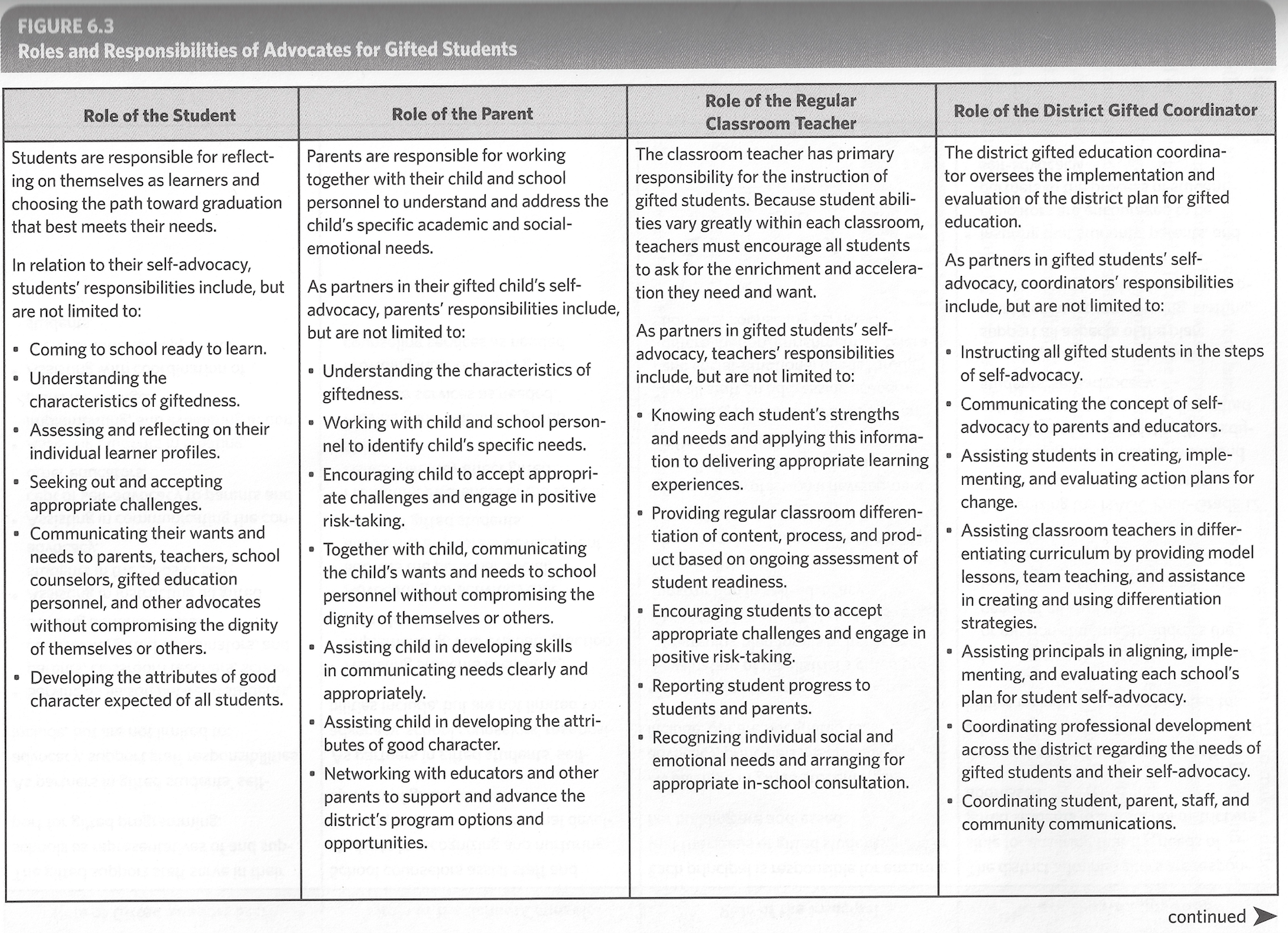
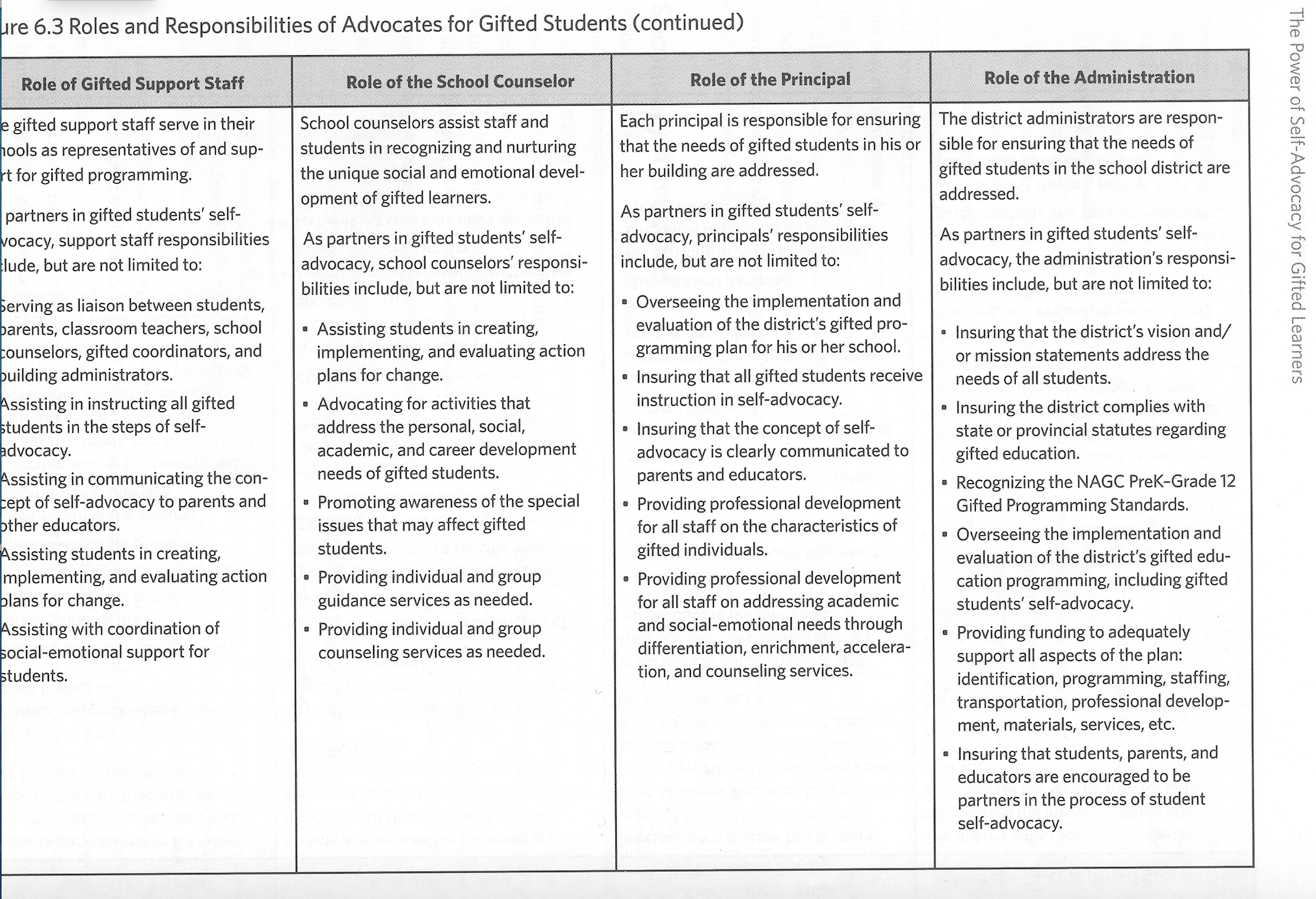
The Power of Self-Advocacy for Gifted Learners by Deb Douglas (2017) Free Spirit Publishing Inc.
The Twice-exceptional Newsletter (now 2e News) published the following issue with several links about advocating for twice exceptional students: Advocacy. Although many of these links are geared toward parents, they are helpful to educators as well.
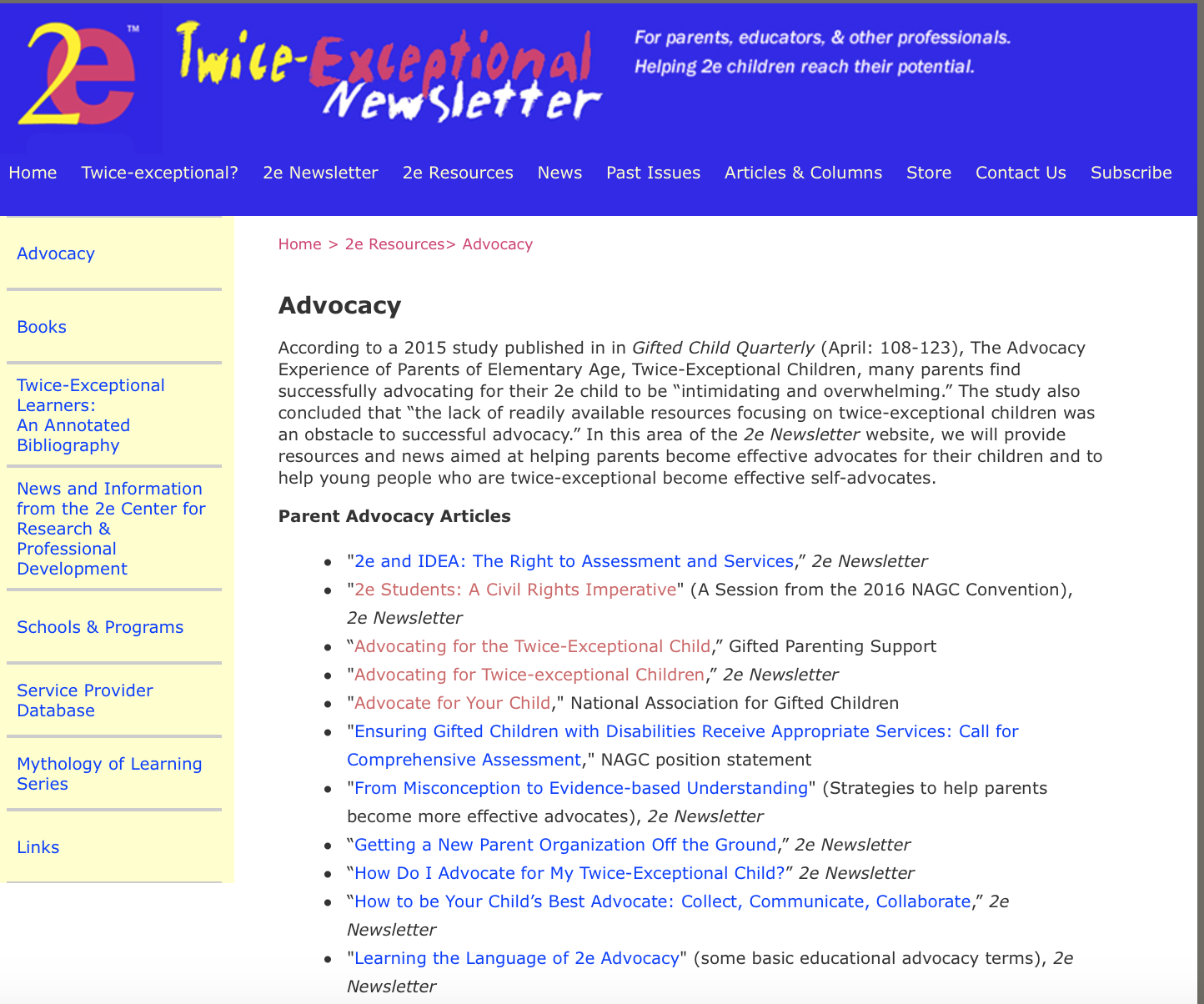
CAGT Advocacy Toolkit
The Colorado Association for Gifted and Talented Advocacy Toolkit is a great resource. CAGT also has a dedicated group of CAGT Affiliates who are “the boots on the ground” that support connections, in particular with parents, across the state. Affiliates respond to questions, provide resources, and assist in problem solving at the local level. CAGT strives to collect feedback from Affiliates to inform implementation of effective policies and to support Affiliates in their efforts to coach families and others in positive advocacy. Check their website to find affiliates in your area.
For additional resources and ideas regarding teaching children self-determination skills such as self-advocacy and self-awareness, visit:
Improve Outcomes in the ALP Process
In order to improve outcomes in the ALP Process, facilitative skills play a big part in advocating what is needed for twice-exceptional learners to support their strengths. Dr. Mary Anne Fleury with the Alternative Dispute Resolution Project at the Colorado Department of Education reminds us how important it is to use respectful language and to use names, not labels. She has summarized facilitative skills to improve the outcomes in the ALP Process. Her suggestion is that the best solution for resolving conflict and building cohesive teams is through the use of facilitative skills for all stakeholders. In the article: Seven Habits of Highly Effective IEP Teams Eileen Hammar and Anne Malatchi note the following things to keep in mind.
Steps for Facilitative Skills
- Be Proactive: take initiative to recognize responsibility to make things happen
- Begin with the end in mind: envision the future possibilities
- Put first things first: create clear mutual understanding of what needs be accomplished--focus on what, not how; results not methods
- Think win-win: seek mutual benefit in all human interactions
- Seek first to understand, then to be understood: In a truly collaborative process educators will listen to and understand parents; parents will listen to and understand educators. Avoid jargon and use language that everyone working with the student can understand
- Synergize: Effective IEPs are those that have been developed collaboratively by a transdisciplinary team.
- Sharpening the saw: "This is the habit of renewal." (Covey) Celebrate achievements made to energize the collaborative journey with the student.
Eileen Hammar and Anne Malatchi (2018): http://www.ldonline.org/article/6360/
The following stages of the CDE Facilitation Process set the groundwork for a successful meeting:
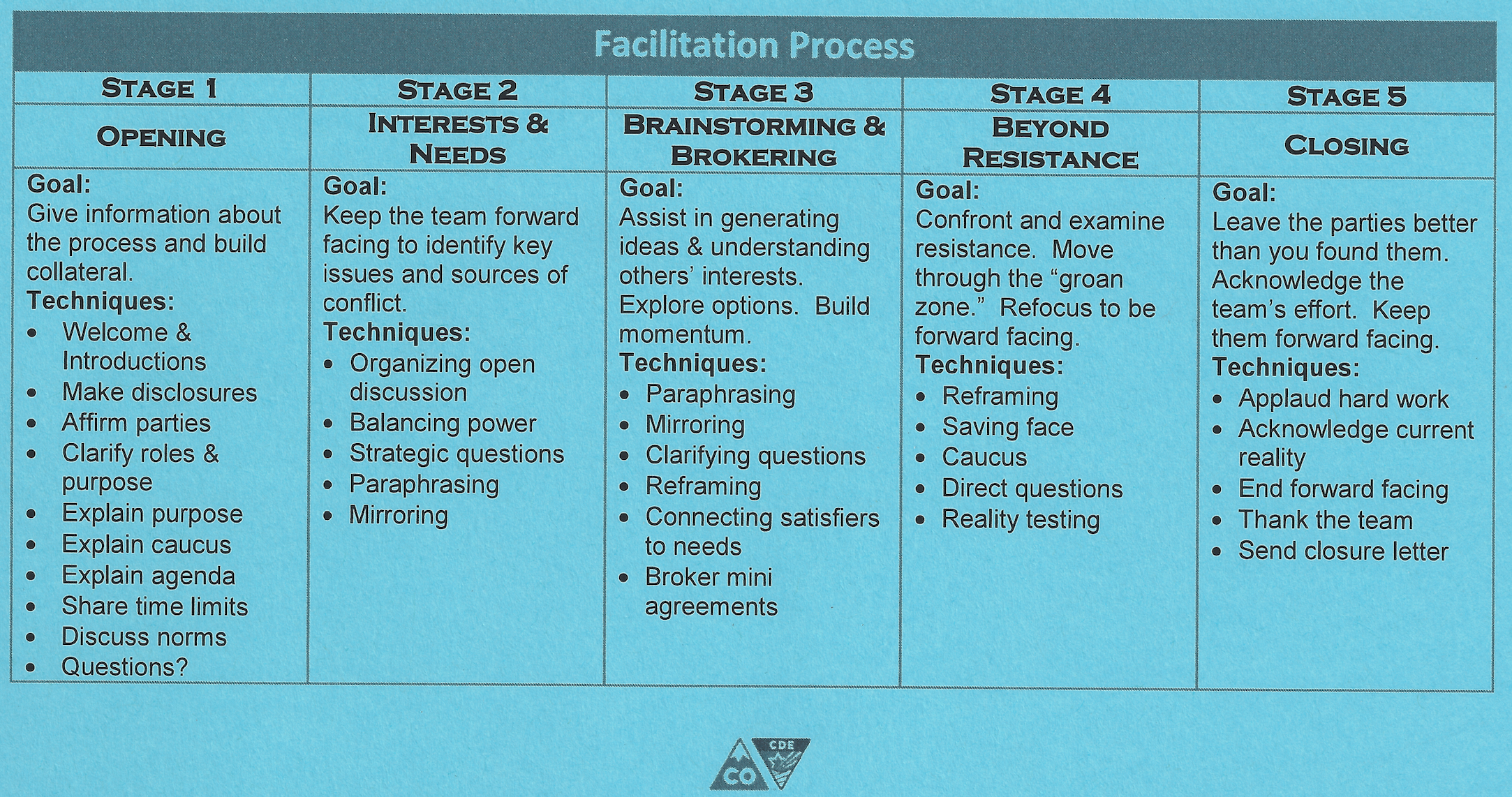
Remember that the opening sets the tone--utilize powerful tools:
- visuals: aid in understanding, keeps team on track, neutralizes information
- opening statement checklist: welcome and introductions, explain purpose of meeting, agenda and meeting norms (seek agreement if used)
- comprehensive evaluation: educational needs means academic, functional, social or behavioral
- FAPE continuum (Free Appropriate Public Education): Evaluation>Present Levels & Need>Measurable goals>Services in the LRE
- Agenda Development: realistic and need for input from team members, document, communicate agenda well, and include document parent input--Parent Reports should include:
- student strengths
- behavioral performance
- social interaction
- parent concerns
- Skills to consider:
- Identifying Sources of Conflict: find source
- Using strategic questions to identify underlying interests: avoid putting participants on defensive, strive for symmetry in the way parties are treated
- Open Ended Questions:helpful for obtaining more detail (ex. tell me more...)
- Problem Solving Questions: to find out what really motivates the parties (ex. Help me to see why this is important to you)--ask why not try...; Ask what if...
- Directing Traffic Questions: CanI hear from someone who hasn't spoken on this topic, let's move to the person on your right; have we reached consensus on this issue?
- Build a bank of questions that are effective for you
- striving for symmetry in tone and body language
- Remember 93% of communication is nonverbal
Collaborative Planning for the 2e Student
A collaborative effort between classroom teachers, special educators, gifted educators, and parents is needed to identify twice-exceptional students and implement strategies to meet their diverse needs. It is essential that the disabilities are identified early so appropriate interventions can be provided at optimum times. Unfortunately, the struggles of many twice-exceptional students go unnoticed for many years, resulting in learning gaps and undeveloped potentials.
Coleman and Gallagher (2015) argue that education of a twice-exceptional (2e) child is no less complex than when doctors and specialists collaborate on the best path to follow for a patient. The provision of flexible, multidimensional, customized supports and services requires a system of education that is capable of dynamic and personalized interventions that respond to a 2e student's learning strengths and challenges. We believe that this wind of education response entails more than an excellent individual teacher...it takes a team. (Coleman and Gallagher. 2015)
The CDE Twice-Exceptional Handbook for Level 2: suggests seven steps to strategic planning for twice-exceptional students:

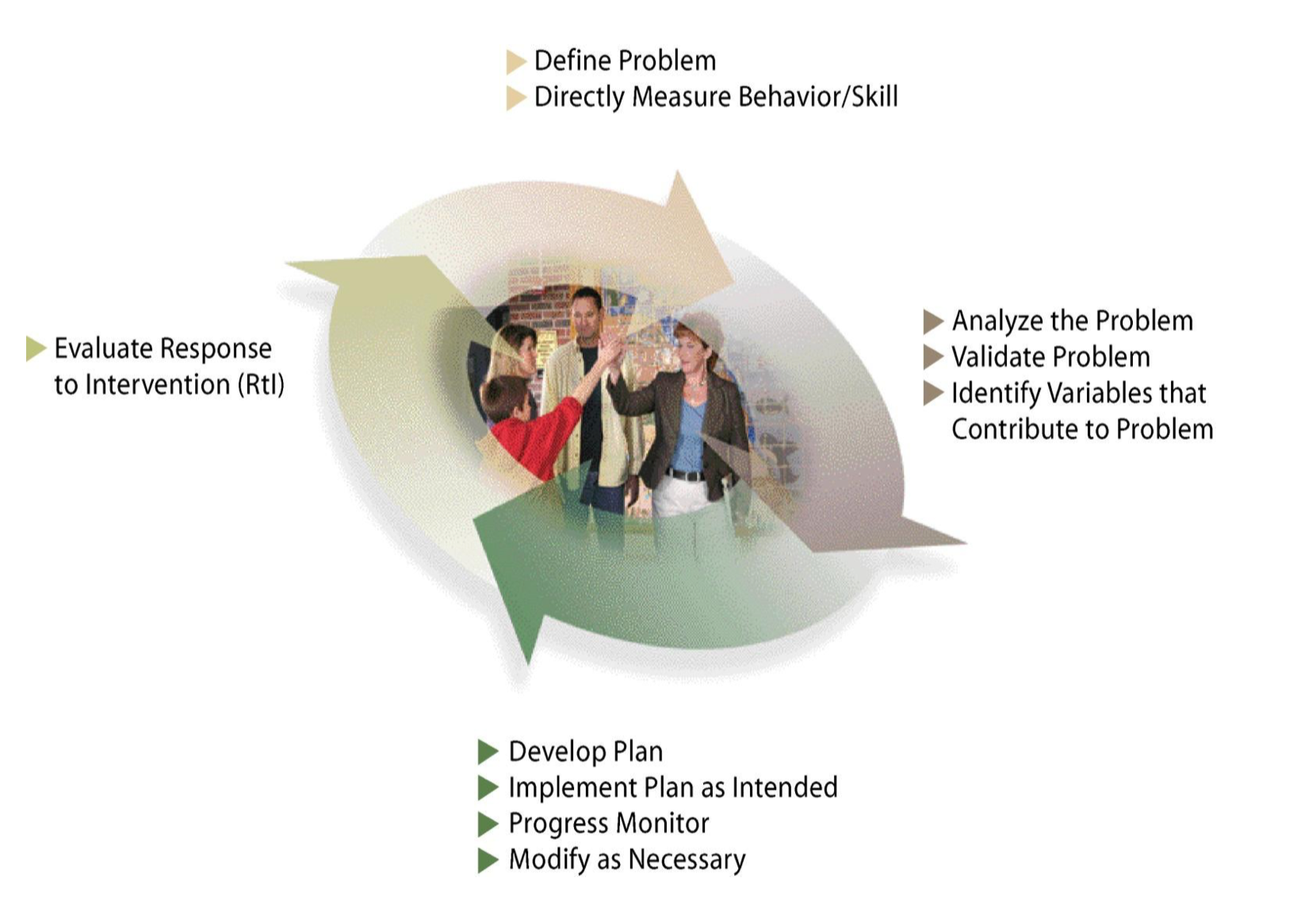
Collaboration
Collaboration can help classroom teachers decipher between 2e students and gifted underachievers. The needs of 2e students can be best supported when special educators, gifted support personnel, and families exercise collaboration (Coleman & Gallagher, 2015). Our goal is to serve the needs of all twice-exceptional students to make certain they receive programming that allows them to recognize their strengths and support their challenges.
Collaboration in planning and instruction for 2e students should be prioritized in schools (Coleman & Gallagher, 2015). The problem-solving team for 2e students should not only include the learning support teacher who provides remediation, but also the designated provider of gifted services. These two professionals should work together to provide a balanced program that addresses the student’s disability while also providing the appropriate level of challenge and opportunity in the areas of giftedness (Baldwin, Baum, Pereles & Hughes, 2015). Although we strive to address strengths before needs as recommended in the research, aiming for a balanced approach calls for many hands. Table 3 lists some common considerations for various stakeholders that may serve as the foundation for deep and relevant collaboration and planning. Strategies for Supporting Students Who Are Twice-Exceptional by Janet Josephson, Charlton Wolfgang, Rich Mehrenberg The Journal of Special Education Apprenticeship, June 2018.
Areas to Collaborate:

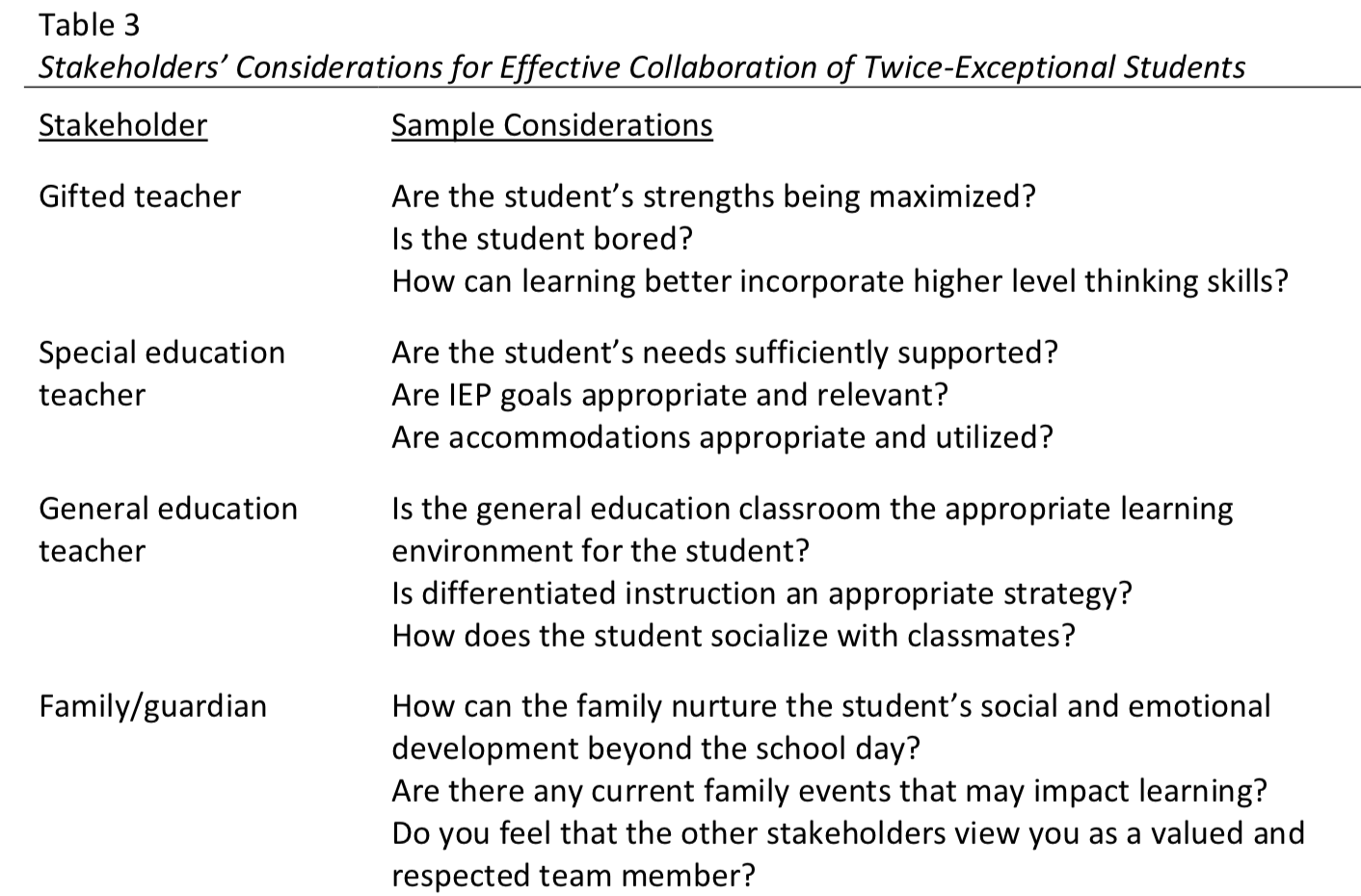
Strategies for Supporting Students Who Are Twice-Exceptional by Janet Josephson, Charlton Wolfgang, and Rich Mehrenberg. THE JOURNAL OF SPECIAL EDUCATION APPRENTICESHIP, 7(2)(2018)
In their article: Meeting the Needs of Students With 2e: It Takes A Team, Mary Ruth Coleman and Shelagh A. Gallagher emphasize the need for flexible, multidimensional, customized supports and services for 2e that require a system of education that is capable of dynamic and personalized interventions that respond to a 2e student's learning strengths and challenges. They believe that this kind of educational response entails more than an excellent individual teacher...it takes a team. Gifted Child Today, October 2015 https://www.researchgate.net/publication/283875493
Supporting twice-exceptional students in the MTSS process may involve a shift in thinking:
- Articulate how MTSS can be used to identify a twice-exceptional student.
- Define and use strength-based programming within an MTSS format to develop an educational plan for a 2X student.
- Collaborate with others to develop an educational plan for a 2X student.
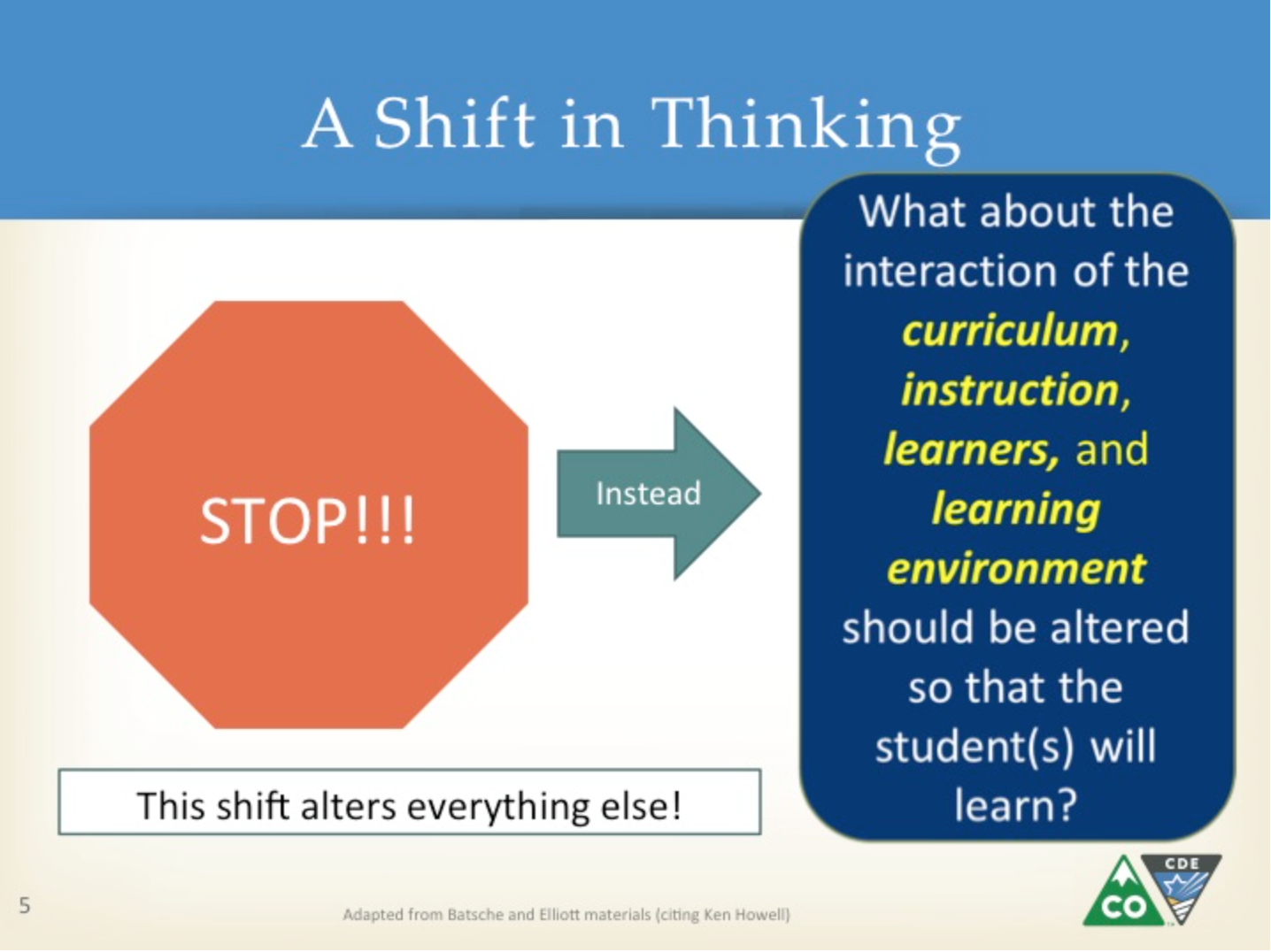
Benefits of MTSS
- Early intervention at the first sign of difficulty without “wait to fail"
- Resources can be pooled (e.g., Reading Recovery, Title I, and special education funds can be used to provide intense interventions)
- Focus will be on student needs - not the disability label
Mary Ruth Coleman, 2004
Meeting Diverse Needs: Collaboration
Twice-exceptional students have learning needs related to both their exceptionalities. To meet the diverse needs of 2X students, a collaborative effort is needed between:
-
-
-
- Classroom teachers
- Gifted education and special education staff
- Parents
- Students
- Community resources
-
-
The Importance of Collaboration
- Expectation of shared responsibility and goal setting
- Varied perspective on identifying twice exceptional student needs
- Developing consensus about instructional decisions for programming options, interventions and available resources
- Collective progress monitoring and data collection
- Community of support for the student
Designing A Process for Collaboration
Collaboration describes how teachers work together, not what they do. (Friend & Bursuck, 2002)
Key elements for general education, gifted and special education teachers working together:
-
-
Shared goal: success of 2e student both academically and emotionally
-
Partnership that evolves over time
-
Process not product
-
Team that supports one another to:
-
-
develop appropriate instructional plans
-
differentiate instruction
-
-
At the beginning of the school year:
-
-
Meet with all stakeholders involved with student both previously and currently to:
-
Review program goals set for the student
-
Emphasize that both exceptionalities must be addressed
-
-
Share the need for a collaborative process with principal to gain their support.
-
Meet with student and guardians to learn about their personal goals/expectations. Explain how collaborative process works.
-
Collaborative Partnerships among Teachers of 2e Students. Kennedy, Higgins and Pierce. 2005
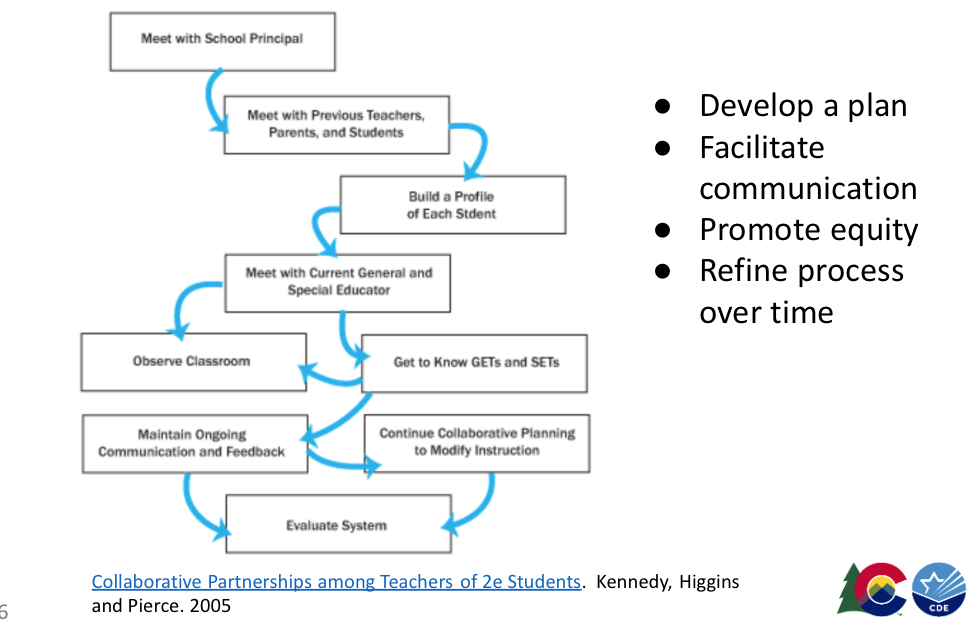
Support the Classroom Teacher:
-
Learn about classroom structure, teaching styles, expectations
-
Provide suggestions to expand curriculum for students
-
Find appropriate materials
-
Work together to design and develop a differentiated curriculum
-
Provide support for modifications
-
Develop a schedule for collaborative planning
-
Collaborate on creation, implementation
-
Partner in evaluation of process using data gained from:
-
Direct observation in classrooms
-
Interviews of teachers, students and guardians
-
Samples of student work (process and product)
- Create a Student Profile:
- Create a Learning Profile
-
-
Put together a learning profile for the student with detailed notes on how they learn, both their weaknesses and their strengths, and update these as more information comes in from assessments.
-
The Student Study Form suggests data that will be helpful to best serve the student.
-
Adapted from “Supporting Twice Exceptional Students in the Classroom” by Amanda Drury, July, 2017
Collaboration With Families
How to Foster Collaboration with Parents/Guardians:
- Personalize contact via phone calls, emails, and face-to-face conferencing
- Consider identifying a staff member to be the main contact
- Communicate positive behaviors and strength area of student prior to discussing challenges
- Obtain information from the parent/guardian about their child (strengths and challenges)
- Promote and include parental/guardian input about programming and interventions addressing strengths and challenges
- Provide ongoing communication regarding the problem solving process and results of programming and interventions
- Ensure that staff members working with the student have all relevant information and support the plan
Our MTSS framework is surrounded by "Family and Community" to illustrate the understanding that the education of the child goes beyond the walls of our schools into the homes and communities of our students and to emphasize the importance of partnerships with family and community to support student success. The members of the child's family are an important part of your support team. The families of twice-exceptional learners need our support but can (and will) contribute to our understanding of their children and provide needed support outside of school.

Include family members - early and often. Be proactive rather than reactive. In the end, the extra effort you put in initially will pay dividends.
- Personalize parental contact via phone calls, emails, and face-to-face conferencing
- Consider identifying a staff member to be the main contact for the parents
- Communicate positive behaviors and strength area of student prior to discussing challenges
- Obtain information from the parent about their child (strengths and challenges)
- Promote and include parental input about programming and interventions addressing strengths and challenges
- Provide ongoing communication regarding the problem solving process and results of programming and interventions
- Ensure that staff members working with the student have all relevant information and support the plan
Focus on Assets
A pattern in research is that students who are identified for special education before their talents are identified are less likely to receive talent programming (Belin-Blank, NAGC, 2020). As was emphasized in the Part 1 course, it is important for the success and well-being of this population that we take a strengths-based approach. The best educational plans for twice-exceptional students highlight strengths and then accommodate weaknesses--in that order.
Research from 2e school, Bridges Academy (Baum, Schader, & Hebert, 2014) revealed that a strengths-based approach that emphasized talent development helps 2e learners: gain a sense of belonging in social group; overcome challenges; develop relationships with mentors; develop expertise in a talent area, and that by incorporation of strengths-based philosophy across curriculum students ' had increased motivation and willingness to address weaknesses (across academic areas).
Twice-exceptional learners should be provided with the opportunity to participate in advanced classes, enrichment activities, or acceleration. Students receiving IEPs or 504 plans are often overlooked for acceleration programming. In 2008, Crim et al. examined IEPs of over one thousand students identified with SLD; 112 were identified as high ability on cognitive measures, but not one was recommended for acceleration programming.Acceleration is one of the effect programming options to means meet a 2e learners gifted needs, but like other programming options, such as advanced courses, it must be accompanied by relevant accommodations--remember dual differentiation from the Part 1 course--which starts by understanding the student’s unique pattern of strengths and weaknesses, and accommodating accordingly. Because of the complexity and heterogeneity in 2e students' skills, curricula should be uniquely tailored to individual needs. For example, a gifted student with dyslexia may be provided with the opportunity to build reading skills within intellectually engaging lesson (Berninger & Abbot, 2013), or a gifted student with ADHD may be provided with the opportunity to cultivate divergent thinking and problem-based learning rather than activities reliant on recollection of fact (Fugate, Zentall, & Gentry, 2013).
Many 2e learners will benefit from allowing them enough time to process information (sometimes adults can misinterpret behavior as defiant when a learner is taking more time to process because of a learning difference) and being taught self-advocacy and problem-solving skills. (in both areas of talent and weakness, especially as they get older)
Although we covered strength-based learning in Part 1, this new article: What Do We Mean By Strength-Based Learning provides ways to incorporate strengths and provides examples.
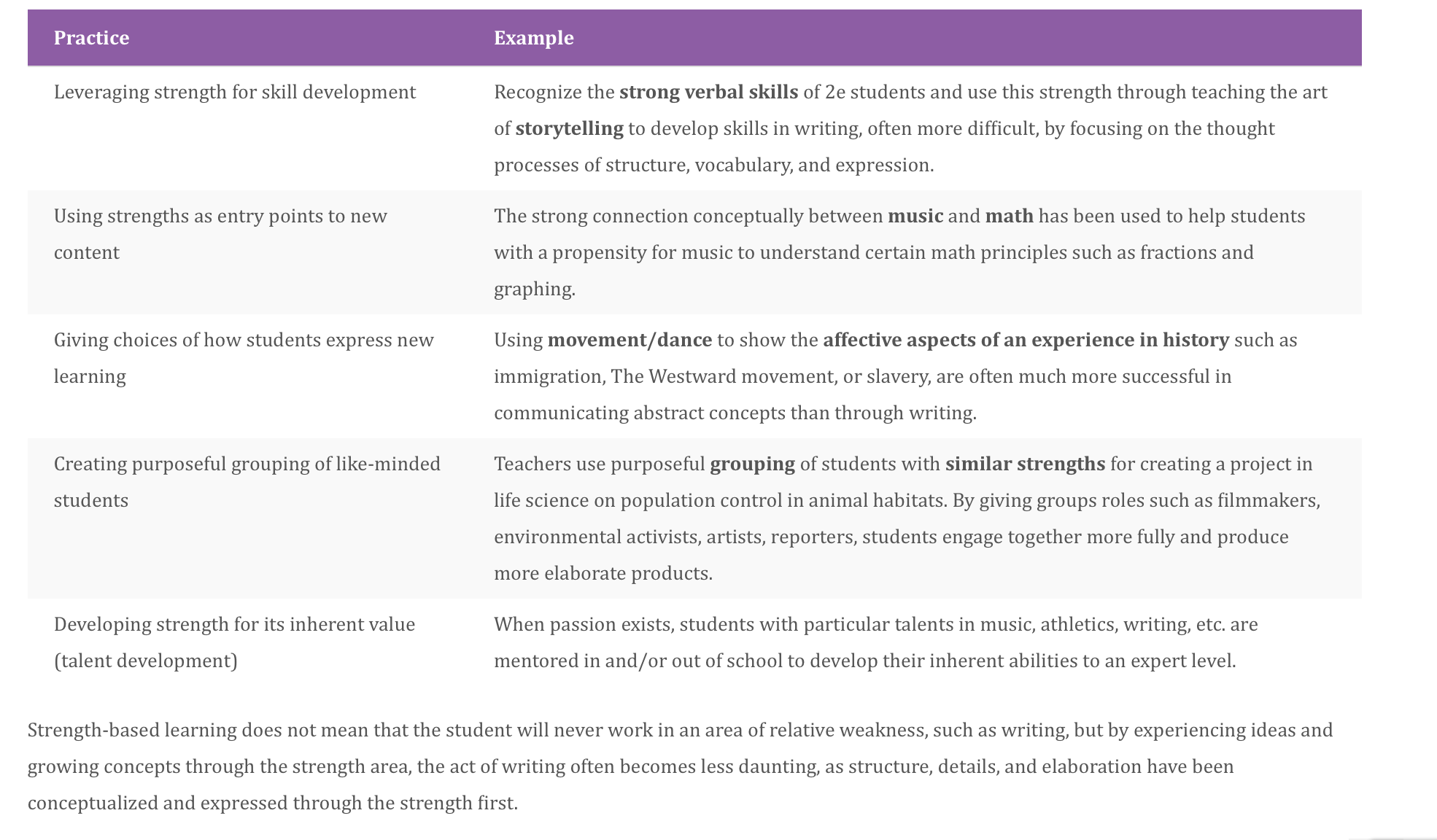
“Teachers initially view the high creativity, critical thinking, curiosity, and problem-solving ability of twice-exceptional learners as exciting, challenging, and positive. But teachers’ enthusiasm for these positive characteristics soon becomes overshadowed by their frustration with these students’ inability to demonstrate academic skills and with their often extreme behavioral difficulties” (Nielson and Higgins, 2005).
2e students are often very frustrating to teachers in the classroom. They don't "play school" well and their own frustration with their uneven abilities, or lack of understanding of how they fit in, leads to behaviors that can be challenging in the classroom. Despite these frustrations, we must remain steadfast to looking at all of their strengths (assets) before trying to work on their struggles (deficits).
This is true in education and life. Let's take a look at an article written by Donnie Maclurcan, who is a co-founder of the Post Growth Institute and an Affiliate Professor of Social Science at Southern Oregon University. His article,
The Power of Asset-based Approaches, gives a glimpse into how a strength-based mindset, or being asset focused, is powerful in all areas of life. (Take some time to click the links below to view the resources shared by Maclurcan; reading the entire article is optional.)
"From the moment you were born, you have been accumulating an incredible array of assets. No matter who you are – your passions, knowledge, skills and access to resources are truly vast."
According to Maclurcan, "when we open processes by reviewing the positives, we engage the imaginative neocortex, not the part of our brains associated with ‘flight, fight or freeze’ response. This enables greater creativity and a “flexible, responsive approach to situations”." Maclurcan does not advocate for a false, cheery disposition that avoids or ignores the real challenges. Instead, he has found that "we start by exploring people’s strengths, we value people as human beings."
Let's take this one step further ... What are the students saying? According to Gallup ( Strengths-Based Education and Student Engagement
by Shane J. Lopez, Ph.D.), "commitment to building the strengths of each student is associated with several of the conditions necessary for student engagement."
84% of students who strongly agreed with “My school is committed to building the strengths of each student” were engaged at school.
As found in The Principles of Strengths-Based Education, strengths-based education is built upon the following assumptions:
- The strengths philosophy explores ways to empower individuals to flourish rather than simply survive (Liesveld & Miller, 2005) and presupposes that capitalizing on one’s best qualities is likely to lead to greater success than would be possible by making a comparable investment of effort into overcoming personal weaknesses or deficiencies (Clifton & Harter, 2003; Clifton & Nelson, 1992).
- Strengths-based models embody a student-centered form of education with the primary goal of transforming students into confident, efficacious, lifelong learners whose work is infused with a sense of purpose (Anderson, 2000).
Shane J Lopez & Michelle C Louis (2009) The Principles of Strengths-Based Education, Journal of College and Character, 10:4, , DOI: 10.2202/1940-1639.1041
What assets does your 2e student bring to your classroom? What are their passions? Knowledge? Skills? Start here...
Being A Catalyst for Change
I am personally convinced that one person can be a change catalyst, a transformer
in any situation, any organization. Such an individual is yeast that can leaven an entire loaf.
It requires vision, initiative, patience, respect, persistence, courage,
and faith to be a transforming leader.
Stephen Covey
How do we get the word out about the needs of our 2e students to our colleagues we work with, our communities and our administration? As the quote above suggests, it does require vision, initiative, patience, respect, persistence and courage. Being the leader who creates awareness about our twice-exceptional students is not always easy. The advocacy section has many ideas and sometimes we really do need to leave our comfort zone like the goldfish below. Starting with a student's strengths is a shift in thinking that can make a significant difference for our students. Thank you for being a leader and change catalyst for our 2e students by taking this class and sharing this information with your fellow educators!
The following are some additional articles that may be of interest on this topic--knowledge is power!
- NAGC Article: Supporting the Needs of Twice Exceptional:
- Twice-Exceptionality: Teachers' Awareness and Training and Their Effects on the Academic, Social and Emotional Outcomes of Students Hopwood, Kimberly Anne.Concordia University Irvine, ProQuest Dissertations Publishing, 2019. 27668759.

Additional Resources
There are many resources available that might be useful as you continue to grow in your understanding of how to identify and support twice-exceptional students. Please copy or bookmark for later use.
2e Students: Who They Are and What They Need. In this article, the author gives a brief history of 2e and describes how to best identify twice-exceptional students and meet their learning needs.
The Goldilocks Question: How to Support your 2e Child and Get it “Just Right”
2e Newsletter - archives (Now 2eNews)
CAGT (Colorado Association of Gifted and Talented)
NAGC (National Association for Gifted Children) -- must create a log-in & password to access material, then search for twice-exceptional
Understood - website for parents of children with learning and attention issues
CEC (Council for Exceptional Children) – information on twice-exceptionality
Hoagies (web page begun by a parent of gifted children)
There are many resources available that might be useful as you continue to grow in your understanding of how to identify and support twice-exceptional students. Please copy or bookmark for later use.
The Goldilocks Question: How to Support your 2e Child and Get it “Just Right”
2e Newsletter - archives (Now 2eNews)
CAGT (Colorado Association of Gifted and Talented)
NAGC (National Association for Gifted Children) -- must create a log-in & password to access material, then search for twice-exceptional
Understood - website for parents of children with learning and attention issues
CEC (Council for Exceptional Children) – information on twice-exceptionality
Hoagies (web page begun by a parent of gifted children)
Believe All Children Can Succeed
Please consider committing to this chapter's heading -- "I believe that all children can succeed." To "give yourself a round of applause," and to inspire and confirm this 30 hour journey, let us end with this 3:33 minute video. (Pay attention to the t-shirt messages.)
Because there is no closed captioning, for lyrics, you can watch this version
